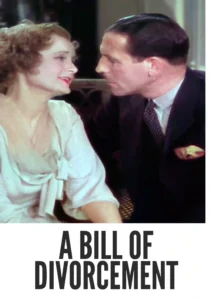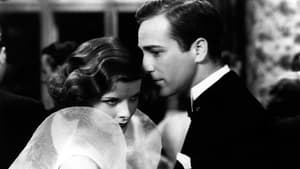Video Sources 0 Views

Download A Bill of Divorcement (1932) Colorized HD | Katharine Hepburn | Emotional Drama Classic
Synopsis
Love, Law, and Heartbreak: A Bill of Divorcement (1932) in Vivid Color

Dive into the emotional depths of A Bill of Divorcement, a compelling drama from 1932, exquisitely colorized to enrich your viewing experience. Starring Katharine Hepburn in her debut role and John Barrymore, this film explores themes of mental health, divorce, and societal expectations during a tumultuous period. Ideal for fans of classic cinema and powerful human stories, this HD download offers a beautifully restored glimpse into early Hollywood’s exploration of complex social issues.
A Bill of Divorcement Storyline: Navigating Love and Sanity
A Bill of Divorcement tells the story of Sydney Fairfield (Katharine Hepburn), a young woman on the brink of marriage when her father, Hilary Fairfield (John Barrymore), returns home after spending years in a mental asylum due to shell shock from World War I. Hilary’s unexpected return throws Sydney’s life into turmoil as she grapples with the potential impact on her future and the well-being of her family.As Hilary tries to reintegrate into society, the family must confront painful truths about his condition and their own relationships. Sydney finds herself torn between her love for her fiancé and her duty to her father, leading to a series of difficult choices and emotional confrontations. The film explores themes of sacrifice, societal stigma, and the complexities of love and family bonds. Ultimately, A Bill of Divorcement is a moving and thought-provoking drama that showcases the challenges faced by individuals and families dealing with mental illness and the changing landscape of divorce laws.
Movie Cast
The film features a stellar cast of actors who bring this emotionally charged story to life:
- John Barrymore as Hilary Fairfield
- Katharine Hepburn as Sydney Fairfield
- Billie Burke as Margaret Fairfield
- David Manners as Kit Humphrey
- Henry Stephenson as Dr. Alliot
Movie Genre
A Bill of Divorcement falls into the genre of emotional drama, exploring themes of mental health, family dynamics, and societal expectations. Its poignant storyline and powerful performances make it a compelling and thought-provoking film.
Historical Context: Early Hepburn and Social Issues in Film
Released in 1932, A Bill of Divorcement marked Katharine Hepburn’s debut in Hollywood, launching her into stardom. The film tackled then-controversial themes such as mental illness and divorce, reflecting the changing social attitudes of the time. Produced during the Pre-Code era, it was able to address these issues with a frankness that would later be restricted by the Hays Code. A Bill of Divorcement provides valuable insights into the social and cultural landscape of the 1930s and the early careers of some of Hollywood’s most iconic actors.
Colorization Details
This colorized version of A Bill of Divorcement has been meticulously restored using modern digital techniques, enhancing the visual appeal while preserving the film’s original emotional depth. The colorization process involved carefully analyzing the grayscale tones of the original black and white footage and assigning appropriate colors to each scene. While the specific software used remains proprietary, the techniques employed included advanced algorithms for color palette selection and image enhancement. This painstaking process brings new life to the characters and settings, making the story even more engaging for modern audiences. While some may debate the merits of colorizing classic films, it introduces these films to a broader audience, ensuring their legacy for future generations.
Technical Details
- Director: George Cukor
- Screenplay: Howard Estabrook, Harry Wagstaff Gribble
- Based on: the play by Clemence Dane
- Cinematography: Sid Hickox
- Edited by: Arthur Roberts
- Production Company: RKO Radio Pictures
- Distributed by: RKO Radio Pictures
- Runtime: 69 minutes
Technical Specifications
- Download Format: MP4
- Resolution: HD (1080p)
- Compatibility: Compatible with most devices, including smartphones, tablets, computers, and smart TVs.
Reviews and Critical Reception
A Bill of Divorcement (1932) is celebrated for its powerful performances and its sensitive exploration of complex social issues. Katharine Hepburn’s debut was widely praised, and the film remains a significant work in both her career and the history of Hollywood cinema. As a thought-provoking and emotionally resonant drama, A Bill of Divorcement continues to resonate with audiences today.
FAQs
- Q: What is A Bill of Divorcement about?
- A: A Bill of Divorcement is a drama about a family grappling with the return of a father who has been in a mental asylum and its impact on their lives.
- Q: Is A Bill of Divorcement (1932) considered an important film?
- A: Yes, it marked Katharine Hepburn’s debut and tackled then-controversial themes of mental illness and divorce.
- Q: Is this version of A Bill of Divorcement colorized?
- A: Yes, this version has been professionally colorized to enhance the viewing experience.
- Q: What makes A Bill of Divorcement interesting for classic film fans?
- A: It offers valuable insights into early Hollywood and the social issues of the 1930s, as well as showcasing the early career of Katharine Hepburn.
- Q: What is the download format?
- A: The download format is MP4, which is compatible with most devices.
- Q: What resolution is the download?
- A: The resolution is HD (1080p), providing a high-quality viewing experience.
Download Now in HD!
Watch A Bill of Divorcement Today!











